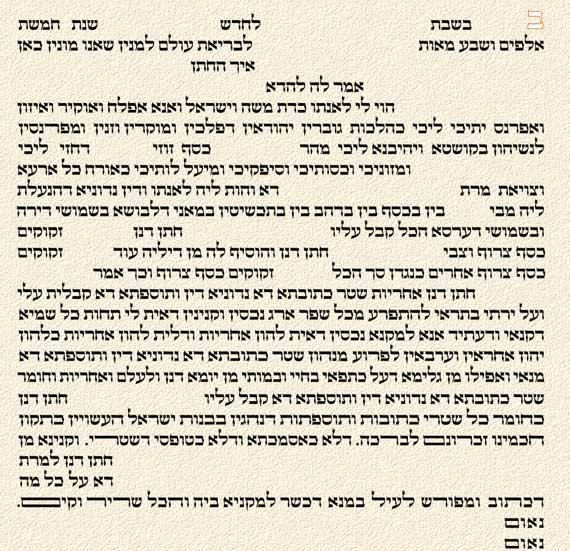By Rabbi Yair Hoffman for 5tjt.com
Join our WhatsApp groupSubscribe to our Daily Roundup Email
It may be worthwhile to print this out and save it for emergencies at a wedding, because it happens more often then we think. In statistics that this author has kept, it happens on average between 1% and 2% of the time. However, it can also happen almost ten percent of the time as well – depending upon the experience of the mesader kiddushin.
A mistake is made in the Kesuvah itself at the wedding. A frantic call is made to a Posaik: “We have no other Kesuvah – what should we do?” [The reader may wish to print this in case of emergencies].
PLEASE HELP A VERY CHOSHUV HACHNASSAS KALLAH SITUATION
https://thechesedfund.com/zechornilah/hachnasaskallah
At times, the Posaik cannot be reached, in which case calls are made to Posaik after Posaik. Sometimes, when the Posaik can be reached, he may suggest that the Kesuvah be re-written by hand. All this is often done behind closed doors and can often lead to delays at the wedding.
There is, however, another possibility, of which many Rabbonim are unaware. It is possible to repair the mistake, as long as the following three conditions are fulfilled:
- One notes on the bottom of the Kesuvah that the correction was, in fact, made
- The notation references the line where the correction was made
- The witnesses attest to the correction.
This is called a Kiyum of the correction. This concept is found in chapter 44 of the Choshain Mishpat section of Shulchan Aruch subparagraph 5.
HOW TO NOTE THE CORRECTION
The mistakes generally fall into four categories:
- A missing letter
- A missing name or missing word
- A misspelled letter or word
- An extra letter or word.
We will go through the correction of each of the above cases.
- If a letter was left out of the original, one may add that missing letter in its place– even above the area, and one adds the following notation at the bottom of the Kesuvah:
Letter X on line Y was added. Vehakol sharir vekayam, and then the witnesses sign.
The Hebrew for this is:
אות ___ בשורה שלישית תלויה והכל שריר וקיים.
- If an entire word or name was left out, the word is added in place – above the area and one adds on the bottom of the Kesuvah:
Word X on line Y was added. Vehakol sharir vekayam, and then the witnesses sign.
The Hebrew for this is:
תיבת ___ בשורה שלישית תלויה והכל שריר וקיים.
- If just one letter was incorrect, it can be crossed out, erased, scratched off, or written over [called ha-avaras kulmus] in its place and one adds on the bottom of the Kesuvah:
Letter X on line Y was erased [or written over] Vehakol sharir vekayam and then the witnesses sign.
The Hebrew for this is:
אות ____ בשורה רביעית מחוקה והכל שריר וקיים
If it was written over, then the Hebrew notation that is to be added is as follows:
אות _____ בשורה ____ בהעברת קולמוס והכל שריר וקיים
If it was a word and not just a letter that was corrected, use the above formulation but replace אות with תיבת.
- If there was an entire extra word that was crossed out, erased, or scratched off, then one adds on the bottom
תיבת _____ בשורה ____ מחוקה והכל שריר וקיים.
TWO SITUATIONS IN WHICH CORRECTIONS CAN BE MADE
The Kesuvah can be corrected in either of two situations:
1] when the witnesses did not yet sign the document – in which case the notation is to be made above where the witnesses sign.
2] After the witnesses have already signed – in which case the same witnesses must sign again below the notation of the correction.
In the second case, the correction can even be made several days later.
Please note that one cannot make a correction on top of a correction on a Kesuvah. You get one chance. [See Nachalas Shiva 3:23]
The above is based upon the psakim of Rav Yaakov Yishayahu Blau zt”l, author of the Pischei Choshain (and one of this author’s first Poskim – dating back some 40 years ago). See Kovaitz Tevunos Aryeh Vol. II.
The author can be reached at [email protected]
PLEASE HELP A VERY CHOSHUV HACHNASSAS KALLAH SITUATION


“it happens on average between 1% and 2% of the time. However, it can also happen almost ten percent of the time as well”
Those statements are contradictory.
A son of the Shevet Halevi zt”l maintains that in his experience, there are a significant minority of cases where the Kesuva should or must be corrected. The best solution, he concludes, is that the officiating Rav should bring a laptop and small printer to the hall, and print it out “real-time” when all verifications and corrections are made. [which may take several cycles!].
I was at a wedding where it happened 150% of the time.